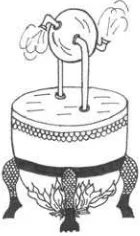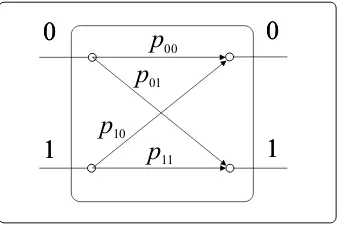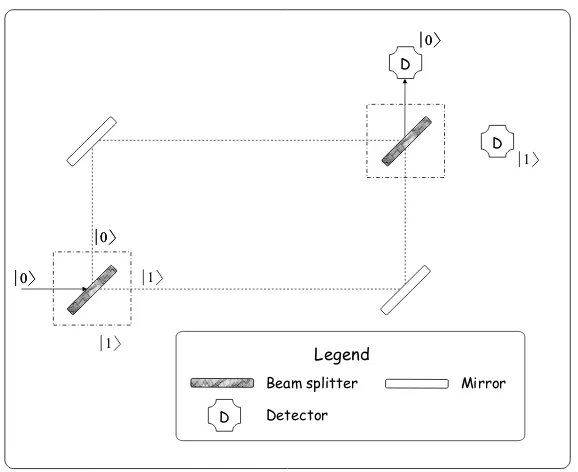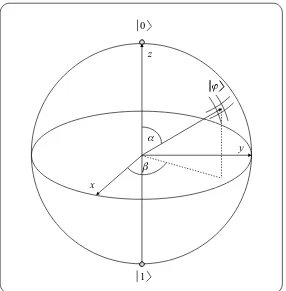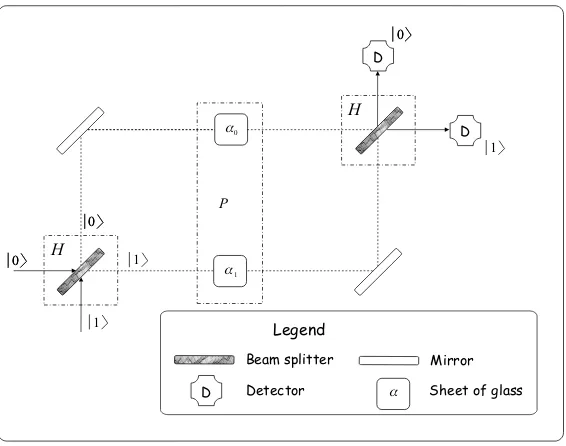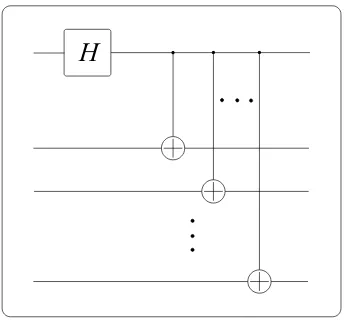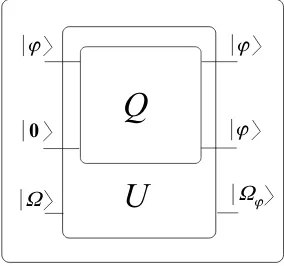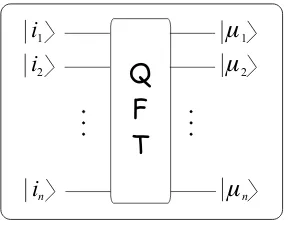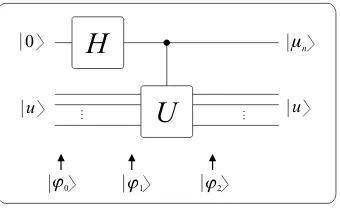Quantum Computing
and Communications
An Engineering Approach
S´andor Imre and Ferenc Bal´azs
Both of
Budapest University of Technology and Economics, Hungary
Quantum Computing and Communications
Quantum Computing
and Communications
An Engineering Approach
S´andor Imre and Ferenc Bal´azs
Both of
Budapest University of Technology and Economics, Hungary
The Atrium, Southern Gate, Chichester, West Sussex PO19 8SQ, England Telephone (+44) 1243 779777
Email (for orders and customer service enquiries): [email protected] Visit our Home Page on www.wileyeurope.com or www.wiley.com
All Rights Reserved. No part of this publication may be reproduced, stored in a retrieval system or transmitted in any form or by any means, electronic, mechanical, photocopying, recording, scanning or otherwise, except under the terms of the Copyright, Designs and Patents Act 1988 or under the terms of a licence issued by the Copyright Licensing Agency Ltd, 90 Tottenham Court Road, London W1T 4LP, UK, without the permission in writing of the Publisher. Requests to the Publisher should be addressed to the Permissions Department, John Wiley & Sons Ltd, The Atrium, Southern Gate, Chichester, West Sussex PO19 8SQ, England, or emailed to [email protected], or faxed to (+44) 1243 770571. This publication is designed to provide accurate and authoritative information in regard to the subject matter covered. It is sold on the understanding that the Publisher is not engaged in rendering professional services. If professional advice or other expert assistance is required, the services of a competent professional should be sought.
Other Wiley Editorial Offices
John Wiley & Sons Inc., 111 River Street, Hoboken, NJ 07030, USA Jossey-Bass, 989 Market Street, San Francisco, CA 94103-1741, USA Wiley-VCH Verlag GmbH, Boschstr. 12, D-69469 Weinheim, Germany
John Wiley & Sons Australia Ltd, 33 Park Road, Milton, Queensland 4064, Australia John Wiley & Sons (Asia) Pte Ltd, 2 Clementi Loop #02-01, Jin Xing Distripark, Singapore 129809
John Wiley & Sons Canada Ltd, 22 Worcester Road, Etobicoke, Ontario, Canada M9W 1L1
British Library Cataloguing in Publication Data
A catalogue record for this book is available from the British Library ISBN 0-470-86902-X
Typeset in LATEX from author-supplied files. Printed and bound in Germany.
To my father who taught me the way of thinking and to my mother who showed me how to endure to the end.
S´andor Imre
Contents
Preface
xiii
How to use this book
xv
Acknowledgments
xvii
List of Figures
xix
Acronyms
xxv
Part I
Introduction to Quantum Computing
1
Motivations
1
1.1
Life Cycle of a Well-known Invention
1
1.2
What about Computers and Computing?
2
1.3
Let us Play Marbles
5
2
Quantum Computing Basics
7
2.1
Mystery of Probabilistic
√IGate
7
2.2
The Postulates of Quantum Mechanics
12
2.3
Qbits and Qregisters
15
2.5
General Description of the Interferometer
22
2.6
Entanglement
25
2.6.1
A surprising quantum state – entanglement
25
2.6.2
The CNOT gate as classical copy machine and
quantum entangler
26
2.6.3
Bell states
28
2.6.4
Entanglement with the environment –
decoherence
30
2.6.5
The EPR paradox and the Bell inequality
33
2.7
No Cloning Theorem
38
2.8
How to Prepare an Arbitrary Superposition
40
2.9
Further Reading
41
3
Measurements
43
3.1
General Measurements
43
3.2
Projective Measurements
44
3.2.1
Measurement operators and the
3rdPostulate
in the case of projective measurement
45
3.2.2
Measurement using the computational basis
states
47
3.2.3
Observable and projective measurement
48
3.2.4
Repeated projective measurement
48
3.2.5
CHSH inequality with entangled particles
49
3.3
Positive Operator Valued Measurement
50
3.3.1
Measurement operators and the
3rdPostulate
in the case of POVM
52
3.3.2
How to apply POVM operators
54
3.4
Relations among the Measurement Types
56
3.5
Quantum Computing-based Solution of the Game
with Marbles
57
3.6
Further Reading
59
Part II
Quantum Algorithms
4
Two Simple Quantum Algorithms
63
4.1
Superdense Coding
63
4.2
Quantum Teleportation
65
CONTENTS ix
5
Quantum Parallelism
69
5.1
Introduction
69
5.2
Deutsch–Jozsa Algorithm
72
5.3
Simon Algorithm
76
5.4
Further Reading
79
6
Quantum Fourier Transform and its Applications
81
6.1
Quantum Fourier Transform
82
6.2
Quantum Phase Estimation
86
6.2.1
Idealistic phase estimation
86
6.2.2
Phase estimation in practical cases
88
6.2.3
Quantitative analysis of the phase estimator
92
6.2.4
Estimating quantum uncertainty
94
6.3
Order Finding and Factoring – Shor Algorithm
100
6.3.1
Connection between factoring and order
finding
100
6.3.2
Quantum-based order finding
102
6.3.3
Error analysis and a numerical example
107
6.4
QFT as generalized Hadamard transform
111
6.5
Generalizations of order finding
115
6.5.1
Period finding
115
6.5.2
Two-dimensional period finding and discrete
logarithm
116
6.6
Further Reading
119
Part III
Quantum-assisted Solutions of Infocom Problems
7
Searching in an Unsorted Database
125
7.1
The Basic Grover Algorithm
126
7.1.1
Initialization – quantum parallelism
126
7.1.2
First stage of
G– the Oracle
128
7.1.3
Second stage of
G– inversion about the
average
129
7.1.4
Required number of iterations
132
7.1.5
Error analysis
135
7.2
Quantum Counting
138
7.2.1
Quantum counting based on phase estimation
138
7.2.3
Replacing quantum counting with indirect
estimation on
M145
7.3
Quantum Existence Testing
147
7.3.1
Error analysis
149
7.4
Finding Extreme Values in an Unsorted Database
151
7.5
The Generalized Grover Algorithm
153
7.5.1
Generalization of the basic Grover database
search algorithm
153
7.5.2
Required number of iterations in the
generalized Grover algorithm
157
7.5.3
Design considerations of the generalized
Grover operator
162
7.6
Further Reading
166
8
Quantum-based Multi-user Detection
169
8.1
Introduction to Code Division Multiple Access and
Classical Multi-user Detection
169
8.1.1
DS-CDMA in theory
171
8.1.2
DS-CDMA in practice
172
8.2
Optimal Multi-user Detection
177
8.3
Quantum-based Multi-user Detection
181
8.4
Further Reading
183
9
Quantum-based Code Breaking
185
9.1
Introduction to Cryptology
185
9.2
Symmetric Key Cryptography
187
9.2.1
Large number of users
188
9.2.2
Length of the key and its randomness
189
9.3
Public Key Cryptography
190
9.3.1
The RSA algorithm
192
9.3.2
Digital signatures
193
9.4
Quantum-based Solutions for Breaking Public Key
Cryptosystems
195
9.4.1
Using Grover’s database search algorithm to
break RSA
195
9.4.2
Using Shor’s order finding algorithm to break
RSA
196
CONTENTS xi
10 Quantum-based Key Distribution
201
10.1 The BB84 Protocol
202
10.1.1 Idealistic scenario
202
10.1.2 Eve appears on the scene
204
10.1.3 When the channel introduces errors
205
10.2 The B92 Algorithm
206
10.3 EPR Paradox Based Key Distribution
208
10.4 Teleportation as a Useful Element in Quantum
Cryptography
208
10.5 Further Reading
209
11 Surfing the WEB on Quantum Basis
213
11.1 Introduction to WEB Surfing
213
11.2 Quantum-based Solution of the Guessing Secret
Problem
216
Part IV
Appendices
12 Mathematical Background
223
12.1 Basic Probability Theory
223
12.1.1 Characterization of random events
223
12.1.2 Decision theory
225
12.2 Linear Algebra
226
12.2.1 Complex numbers
226
12.2.2 Gaussian elimination
226
12.2.3 Vector spaces
227
12.2.4 Eigenvectors and eigenvalues
230
12.2.5 Special linear operators
230
12.2.6 Operator functions
232
12.3 Number Theory
232
12.3.1 Modular arithmetic
232
12.3.2 Definitions
233
12.3.3 Euclid’s algorithm
234
12.3.4 Continued fraction and convergents
235
13 Derivations Related to the Generalized Grover Algorithm
239
13.1 Eigenvalues of the Generalized Grover Operator
239
13.2 Eigenvectors of the Generalized Grover Operator
241
14 Complex Baseband-equivalent Description of Bandlimited
Signals
245
15 Useful Links
247
References
249
Solutions of Exercises
261
Preface
Quantum computing and communications is one of the promising new fields of the new millennium. This emerging topic has reached the age when not only physicists and mathematicians but also engineers are becoming more and more interested in it. This book is based on the first semester of a two-semester subject dedicated to Ph.D. students and undergraduates in electrical engineering and computer sciences at Budapest University of Technology and Economics. This first semester covers a thorough basic introduction to the quantum computing world and discusses quantum-assistedcomputing and communications where we use the new paradigm to improve (assist) the performance of classical systems (e.g. searching in an unsorted database or strengthening communication security). In addition the second semester deals withquantum-basedcommunications or more precisely with quantum information theory (e.g. channel capacity, error correction). After six semesters of experience we decided to prepare a book which can be used both as lecture notes and as a standalone learning aid for colleagues with engineering practice.
and a logical chain of thoughts before reaching an answer to the original problem. If this ‘special’ viewpoint is omitted, which happens often when the authors are not familiar with engineers’ everyday lives, then it always leaves behind a lack of completeness.
Another important aspect for engineers can be summarized as the ‘need for practical applications’. A new theory or even an algorithm in itself has limited value. One has to prove and show that their implementation constraints, such as computational complexity, required memory, etc., can be fulfilled in the case of certain practical applications. Furthermore an unambiguous mapping of theoretical and real-life parameters has to be provided.
Finally, working as an engineer means the permanent study of the science of making compromises. The outcome of a design process must be precise enough andcheap enough andmanageable enoughand etc. and not the most precise or the cheapestorthe most manageableor etc. Hence error analysis must always be kept at the focus of investigations.
All these endeavors are motivated by the fact that engineers should learn how todesign new practical solutions. We always have this philosophy in sight when addressing various topics of quantum computing and communications. Of course we do not want to rank the engineering approach above those of physicists and mathematicians, we simply state that they are different (and not better or worse) in some sense. Due to this fact learning and understanding are much easier if explanations follow the way we are used to.
From a background mathematics’ point of view we assumed a typical curriculum of engineers and computer scientists, however, the required math has been summarized in the appendix.
Because of the limited size of this book there are some aspects that are not discussed in detail. We did not devote an individual chapter to the implementation questions of quantum computers. Instead at the end of each chapter in theFurther Readingwe give a state-of-the-art survey of the current status of implementation and provide up-to-date references for interested readers. Philosophical questions and answers are also beyond the scope of this book but we suggest reading e.g. [84, 145] if the reader has time and would like to widen his/her knowledge.
Now we invite the reader to join us on the journey which is going to pass sometimes interesting, sometimes strange and sometimes challenging lands of the quantum world. Do not hesitate, the new world is waiting for you. . .
How to use this book
According to ancient legend, one day Alexander the Great, conqueror of the ‘that time known world’ (Greece, Egypt, Persia), asked Menaikhmos the famous mathematician to teach him geometry in an easier and faster way. Menaikhmos smiled at this wish and answered: ‘Oh king, you ordered your engineers to build distinct roads for citizens and for messengers and the army of the king all around your empire, but there is only one road for all in geometry!’1
Basically we agree with Menaikhmos: learning and understanding quantum computing and communications need time and effort from the reader. However, we are convinced that if the way the knowledge is served is chosen carefully and fits more or less to previous studies of the reader, then high spirits can be maintained at hard portions of the topic. Before starting the voyage we would like to provide some useful hints and tools similarly to seamen who check their maps and compasses before sailing out to sea.
This book can be divided logically into three well-defined parts. Part I explains the basics of quantum computing and communications. As the next level Part II introduces well-known quantum algorithms while advanced readers can find several quantum assisted solutions for state-of-the-art infocom problems in Part III. The book has been equipped with several special features intended to help the reader.
• A dedicated web site can be found at www.mcl.hu/qcc containing useful information related to this book.
• All the used notations, acronyms and abbreviations are summarized at the beginning of this book so that the reader can turn to this list at any time.
• We prepared plenty of exercises from easy to hard-to-answer types, which allow the reader to test whether his/her understanding is appropriate. The solutions of exercises can be downloaded from the web site of this book or a hard copy can be obtained from the publisher. We do not claim, however, that the proposed solutions are the simplest and shortest ones. Therefore we encourage diligent readers to find more attractive solutions and send them to the authors ([email protected]) in latex format. Appropriate alternatives will be included with the names of their solver into the solutions file.
• As a life belt the reader may find a summary of corresponding mathematical background in the appendices.
• In order to allow the reader to widen his/her knowledge beyond the scope and size of this book a carefully selected large list of references has been attached. We took special care to choose – if possible – such publications that can be accessed electronically on the Internet so that the reader may save time (and money).
• The book is amended with a list containing links to the web pages of the most important leading institutes and laboratories where additional information can be found or even current activities can be followed.
Acknowledgments
The authors gratefully acknowledge the comments and helpful advice of Prof. Katalin Friedl from the Computer and Automation Research Institute of the Hungarian Academy of Sciences. Pressure from and interest of students attending the corresponding courses were the most motivating issues that helped us keep the deadlines. We thank our boss Prof. Laszl´o Pap for the permanent encouragement and allowing us enough free time to complete the work.
List of Figures
1.1
Heron’s ball about 100 B.C.
2
1.2
Moore’s law
4
1.3
Alice and Bob are playing marbles
6
2.1
Scientific model for coin tossing
8
2.2
Scientific model for concatenated coin tossing
9
2.3
Concatenated probabilistic
√Igates
10
2.4
Implementation of probabilistic
√Igate – the
half-silvered mirror
11
2.5
Concatenated half-silvered mirrors as identity
transformation
12
2.6
Geometrical visualization of one qbit in the Bloch
sphere
17
2.7
Generalized interferometer
23
2.8
Abstract quantum circuit of the generalized
interferometer
23
2.10 SWAP gate made of CNOTs
28
2.11 Bell state generator quantum circuit
29
2.12 Generalized quantum entangler
30
2.13 Quantum COPY machine
39
2.14 Abstract quantum circuit of the generalized
interferometer
41
3.1
P(m= 2)and
P(m= 2) = 1vs.
α55
3.2
P(1| |ϕ1)and
P(1| |ϕ1) = 1vs.
α56
3.3
Implementing general measurement by means of a
projective one
57
3.4
Alice and Bob are playing marbles using quantum
strategy
59
4.1
The superdense coding scenario
64
4.2
The teleportation scenario
67
5.1
f-controlled CNOT gate
70
5.2
f-controlled CNOT gate with
N-dimensional control
input implementing parallel evaluation of
f71
5.3
Quantum architecture for solving the Deutsch–Jozsa
problem
74
5.4
Quantum architecture for solving Simon’s problem
76
6.1
Sketch of QFT circuit
84
6.2
Circuit of
Un−185
6.3
Quantum circuit implementing QFT
85
6.4
Quantum circuit producing
|µn87
6.5
Quantum circuit computing the phase
88
6.6
Illustration of probability amplitude regions before
measurement with different index transformations
90
6.7
log10(P(h))in case
c= 10, p= 4and
αu= 0.4π94
6.8
log10(P(h))in case
c = 10and
αu = 0.4·2πwhen
pLIST OF FIGURES xxi
6.9
Psvs.
pin case
c= 10and
αu= 0.4·2π95
6.10
log10(|∆u|)vs.
pin case
c= 10and
αu = 0.4·2π96
6.11 Trade off between
cand
pat fixed
n= 1096
6.12
Psvs.
cand
∆uif
p= 097
6.13 Quantum error probability
log10( ˘Pε) vs. number ofrequired additional qbits
p99
6.14 Quantum circuit implementing order finding
103
6.15
P(i)assuming
n= 11, N= 33, x= 5, r= 10112
6.16
log10(P(i))assuming
n= 11, N= 33, x= 5, r= 10112
6.17 Deutsch–Jozsa circuit as a decision maker whether
fis constant or varying
113
6.18 Deutsch–Jozsa circuit as a simple phase estimator
114
6.19 Period-finding quantum circuit over
ZN116
6.20 Two-dimensional period-finding quantum circuit
118
7.1
Circuit implementing the Grover operator
127
7.2
Probability amplitude distribution of the index register
at
|ϕ1127
7.3
Content of qregister
|γ2after invoking the Oracle
128
7.4
Effect of inversion about the average
a130
7.5
Geometrical interpretation of the Grover operator
133
7.6
Explanation of the decision about the number of
iterations
135
7.7
Pε, Ps,Pε˜and
Ps˜vs.
MN
137
7.8
Quantum counting circuit
139
7.9
Ωγ(M),Ωγ+(M),Ωγ−(M)vs.
qif
M = 1024and
N= 4096141
7.10
c(M, q)(assuming equality in the definition) vs.
qif
M = 1,4,64,2048
and
N = 4096141
7.11 Connection between
Mand
qassuming system
parameters
Pε˘ = 0.1and
2N = 4096144
7.13 Optimal number of rotations
Lvs.
Mmaxif
N= 4096147
7.14 Optimized expected total number of Grover operators
E(z|L)vs.
Mmaxif
N = 4096with
√Nand
N/Mmaxas
references
148
7.15 The matching condition between
φand
θwith and
without correction assuming
Ω = 0.5,
Ωγ2 = 0.0001
,
Λγ = 0.004
,
Λ = 0.004161
7.16 Geometrical interpretation of the generalized Grover
iteration
162
7.17 Different possible interpretations of
|γ1′163
7.18
Υvs.
θassuming
Ω = 0.5,
Ωγ2 = 0.0001
,
Λγ = 0.004,
Λ = 0.004
163
7.19 Number of iterations
lsvs.
θassuming the matching
condition is fulfilled and
Ω = 0.0001,
Ωγ2 = 0.0001
,
Λγ = Λ = 0
165
8.1
Idealistic DS-CDMA architecture
172
8.2
Sequences, modulation and detection in DS-CDMA
173
8.3
Separation in the detector
173
8.4
Mobile access directions
174
8.5
Detection in the case of delayed signal
175
8.6
DS-CDMA transmitter and channel
175
8.7
Single-user DS-CDMA detector with matched filter,
idealistic case
178
8.8
Multi-user DS-CDMA detector
179
8.9
System concept of quantum counting-based multi-user
DS-CDMA detector
183
8.10 The structure of the index register
183
9.1
Basic concept of secure information transfer
187
9.2
Basic concept of symmetric key cryptosystems
188
9.3
Symmetric key cryptosystem in a public mobile
network
189
LIST OF FIGURES xxiii
9.5
Architecture implementing the Diffie–Hellman
concept
191
9.6
Architecture implementing the digital signature
concept
193
9.7
log10(·)of required time in seconds to break the RSA
with different methods
197
9.8
log10(·)of required time in seconds to break the RSA
with different methods (enlarged)
197
10.1 Steps of BB84 protocol if no eavesdropper is present
and the channel is idealistic
203
10.2 Eve’s eavesdropping equipment
204
10.3 Steps of BB84 protocol if Eve is present and the
channel is idealistic
205
10.4 Steps of B92 protocol if Eve is not present and the
channel is idealistic
207
10.5 Equivalence of two- and three-party version of BB84
protocol
209
11.1 The ‘All-IP’ concept
214
11.2 Graph representation of the Guessing Secrets problem
217
1
Geometrical interpretation to
Exercise6.4 and
Exercise
6.5
266
Acronyms
BER
Bit Error Ratio
BPSK
Binary Phase Shift Keying
CAC
Call Admission Control
CDMA
Code Division Multiple Access
DES
Data Encryption Standard
DCT
Discrete Cosine Transform
DFT
Discrete Fourier Transform
DNS
Domain Name Server
DS-CDMA Direct Sequence-Code Division Multiple Access
FDM
Frequency Division Multiplexing
FDMA
Frequency Division Multiple Access
FFT
Fast Fourier Transform
HLR
Home Location Register
GSM
Global System for Mobile communications
GUT
Great Unified Theory
LSB
Least Significant Bit
MSB
Most Significant Bit
probability density function
MAC
Medium Access Control
MAP
Maximum
A Posteriori
ML
Maximum Likelihood
MLS
Maximum Likelihood Sequence
MUD
Multiuser Detection
NMR
Nuclear Magnetic Resonance
PG
Processing Gain
QC
Quantum Computation/Quantum Computing
QFT
Quantum Fourier Transform
QMUD
Quantum-based Multiuser Detection
SDM
Space Division Multiplexing
SDMA
Space Division Multiple Access
SIM
Subscriber Identity Module
SRM
Square-Root Measurement
SS
Spread Spectrum
TDM
Time Division Multiplexing
TDMA
Time Division Multiple Access
UMTS
Universal Mobile Telecommunication System
URL
Uniform Resource Locator
WCDMA
Wideband Code Division Multiple Access
WLAN
Wireless Local Area Network
WWW
World Wide Web
˜
a
Measured/estimated value of variable
a
˘
a
Technical constraint/demand for variable
a, e.g.
a
must
be less than
˘
a
∀
for all
j
√
−
1
|·
Vector representing a quantum state, its coordinates are
probability amplitudes
x
Traditional vector, e.g.
x
∈ {
0,
1
}
nrefers to the vector
ACRONYMS xxvii
|·
NState of an
N-dimensional quantum register, i.e. the
qregister contains
n
= ld(
N
)
qbits
|
0
Special notion for the more than one-qbit zero
computational basis vector to distinguish it from the
single qbit
|
0
U
Operator
U
⊗nn-qbit (2
n-dimensional) operator
U
Matrix of operator
U
P
(α)
Phase gate with matrix
1
0
1
e
jαH
Hadamard gate with matrix
√1 21
1
1
−
1
X
Pauli-X
(bit-flip) gate with matrix
0 1
1 0
Y
Pauli-Y
gate with matrix
0
−
j
j
0
Z
Pauli-Z
(phase-flip) gate with matrix
1
0
0
−
1
⊗
Tensor product; this notation is often omitted, it is used
only if the tensor product operation has to be emphasized
⊕
Modulo 2 addition
(
·
)
∗Complex conjugate
·|·
Inner product
|··|
Outer product
†
Adjoint
(
·
)
TTranspose
∗
Convolution
Definition
≡
Equivalence
∧
Logical AND operator
∨
Logical OR operator
|
Logical IF operator
Z
2≡ {
0
,
1
}
Set of binary numbers
(
Z
2)n≡ {
0
,
1
}
n≡ {
0
,
1
}
nSet of
n-bit binary numbers
Z
N≡ {
0,
1, . . . , N
−
1
}
Set of positive integer numbers between
0
and
(N
−
1),
i.e. set belonging to the modulo
N
additive group
Z
+Set of natural numbers, i.e. positive integer numbers
Z
−Set of negative integer numbers
Z
∗p
Set of positive integers belonging to the modulo
N
multiplicative group
C
Set of complex numbers
ld(
·
)
Logarithmus dualis
,
log
2(
·
)
⌈·⌉
Smallest integer greater than or equal to a number
⌊·⌋
Greatest integer less than or equal to a number
⌊·⌉
Rounds to the nearest integer
gcd(a, b)
Greatest common divisor of
a
and
b
δ(x
−
x
0)Dirac function, it is 1 if its argument equals zero i.e.
x
=
x
0else it is zero everywhere
E
(x)
Expected value of random variable
x
f(x)
Function continuous in
x
f
[
x
]
Function discrete in
x
ℜ
(
x
)
Real part of complex number
x
ℑ
(
x
)
Imaginary part of complex number
x
#(
·
)
Number of, counts the occurrence of its argument
Thin line
Quantum channel
Part I
1
Motivations
1.1 LIFE CYCLE OF A WELL-KNOWN INVENTION
Every invention/technology has its own life cycle, similar to a human being. It can be shorter or longer but all of them have common phases and stages. Let us summarize this evolution using the well-known example of steam engine. First, scientists spend lots of time to find out something new. In our case Heron, a most famous experimenter, designed and implemented a steam-engined ball named Heron’s ball (see Fig. 1.1).
Once a new idea has been born a long period of time is required until the stage when size, cost, efficiency, etc. of pieces of this equipment reach a minimally required and acceptable level. Many amateurs and experts devote their life to fulfil these requirements representing the childhood of the technology. The way is paved with many failures and rare successes therefore most of them remain anonymous forever. However, one day a clever guy manages to combine the small pieces of former results and adds something to them thus finally he/she succeeds. Concerning our example James Watt built the first working steam engine in 1765. Thanks to Mr. Watt steam technology attained its majority.
In the third phase the technology emerges from the deep of dark and mysterious laboratories and begins spreading among everyday people. Fulton’s shipClermont in 1807 irreversibly ended the glorious age of sailing ships and men of war while Stephenson’s Rocket in 1829 convinced the skeptics that railway would be the leading transportation solution on land in the future. Human, sail and animal power had been replaced by steam engines during some decades from the kitchens via workshops up to enormously large ships such asTitanicor the battleships of World
Quantum Computing and Communications S. Imre, F. Bal´azs c
Fig. 1.1 Heron’s ball about 100 B.C.
War I. The efficiency of the largest steam engine reached 22000 kW in 1941. Of course to achieve this level of popularity geniuses have to overcome strong resistance from those who exert the power. For instance William Symington built a steam-engined towboat on the Thames and presented her capabilities. Unfortunately the officials prohibited Symington from using the boat because they were afraid that the waves generated by the boat might damage the river-bank.
The size/power in itself is, however, not enough to survive (cf. dinosaurs or large empires). After a certain point efficiencybecomes as important as power. It was foreseen and proven theoretically – long before steam-powered systems reached the top – that the efficiency of any steam-engine is limited and not enough for example for flight. If the new demand cannot be satisfied by means of a certain technology then other, even very young ideas are brought to light while the old one will be squeezed gradually. The reader may guess the name of the new pretender: yes, it was the internal combustion engine.
1.2 WHAT ABOUT COMPUTERS AND COMPUTING?
WHAT ABOUT COMPUTERS AND COMPUTING? 3
stored program’ principle.1This principle combined with the vacuum tube hardware
which formed the basis of the first successful computers.2Unfortunately the tubes
strongly limited the possibilities of miniaturization hence the first computers filled up a whole room, which strongly restricted their wide applications. Therefore scientists paid attention to the small-scale behavior of matter. Fortunately the invention of semiconductors and the appearance of the transistor in 1948 by Bardeen, Brattain and Schockley opened the way to personal computers and other handheld equipment. One day in 1965 when Gordon Moore from Intel was preparing his talk and started to draw a plot about the performance of memory chips he suddenly observed an interesting rule called Moore’s law. As it is depicted in Fig. 1.2 he concluded that since the invention of the transistor the number of transistors per chip roughly doubled every 18–24 months, which means an exponential increase in the computing power of computers. Although it was an empirical observation without theoretical proof the law seems to be still valid nowadays. However, similar to the case of steam engine farseeing experts tried to determine the future of this technology. They estimate serious problems around 2015. What reasons may stand behind this prophecy?
No matter how surprising it sounds this trend can be traced back simply to drawing lines. The growth in processors’ performance is due to the fact that we put more and more transistors on the same size chip. This requires smaller and smaller transistors, which can be achieved if we are able to draw thinner and thinner – even much thinner than a hair – lines onto the surface of a semiconductor disk. Next current technology enables us to remove or retain parts of the disk according to the line structure evolving to transistors, diodes, contacts, etc. Apart from the technical problem of drawing such thin lines one day our lines will leave our well-known natural environment with well-well-known rules revealed step by step during the evolution of human race and enter into a new world where the traveler must obey new and strange rules if he/she would like to pass through this land. The new world is called nano-world, the new rules are explained by quantum mechanics and the border between the worlds lies around nanometer (10−9m) thickness. Fortunately
scientists have already performed many reconnaissance missions in the nano-scale region thus we have not only theoretical but also technology-related knowledge in our hands called nanotechnology.
From a computer scientist’s point of view, who has algorithms and programs in his/her mind, the growth in the capabilities of the underlying hardware is vital. If we have an algorithm which is not efficient often enough time alone solves the problem due to the faster new hardware. We can say that we got used to Moore’s law during the last decades and forgot to follow what is happening and what will happen with the hardware. For decades, this attitude was irrelevant but the deadline to change it is near to its expiration. Fortunately experts called our attention to the fact that we
1The third area where he is counted among the founding fathers is called game theory.
Electrons
per
device
Year
Transistors per chip
2004 2000 1996 1992
1988 2008 2012 2016 2020
100
101
102
103
1044M
16M 64M
256M 1G
4G 16G
Fig. 1.2 Moore’s law
will have to face serious problems if this trend cannot be maintained. One thing is sure, however, the closer we are to the one-electron transistor (see Fig. 1.2) disturbing quantum effects will appear more often and stronger. Hence either we manage to find a new way of miniaturization or we have to learn how to exploit the difficulties and strangeness of quantum mechanics. Independently from the chosen way we must do something becauseComputing is a mustor as ancient Romans said “Navigare necesse est!”
In compliance with the latter concept Feynman suggested a new straightforward approach. Instead of regarding computers as devices working under the laws of classical physics – which is common sense – let us consider their operation as a special case of a more general theory governed by quantum mechanics. Thus the way becomes open from the hardware point of view. On the other hand hardware and software always influence each other. Since new hardware concepts require and enable new software concepts we have to study quantum mechanics from a computer science point of view. Moreover it is worth seeking algorithms which are more efficient than their best classical counterparts thanks to the exploited possibilities available only in the quantum world. These software-related efforts are comprehended by quantum computing. Once we familiarized ourselves with quantum-faced computing why keep communications away from the new chances. May be the capacity of a quantum channel could exceed that of classical cable or we could design more secure protocols than currently applied ones.Quantum communicationsorquantum information theorytries to answer these questions.
LET US PLAY MARBLES 5
milestones. Top experts have experimentally validated algorithms which overcome the classical competitors. For instance we are able to find an item in an unsorted database or factorize large numbers very quickly. Quantum principles allow solving easily a long discussed problem, namely random number generators e.g. [21]. Furthermore as we mentioned before, implementation of certain algorithms reached such a stage that one can buy corresponding equipment in an appropriate shop. Fortunately many questions are waiting to be answered thus the reader will find not only solutions but open questions in this book. Nothing shores up more convincing the spreading of the new paradigm than the fact that more and more publications appear in popular science magazines and journals [38, 22, 110, 115].
Remark:Moore’s law has several interpretations depending on which side of the market it has been phrased
• Rock’s law: “The cost of capital equipment to build semiconductors will double every four years.” by Arthur Rock (industry)
• Machrone’s law: “The machine you wants always costs $5000.” by Bill Machrone (customer)
• If the reader is familiar with other versions of Moore’s law we ask him/her to post it to the authors ([email protected]) so that we will share them on the book’s web page.
1.3 LET US PLAY MARBLES
Playing games is as old as humankind. To give further motivations to study quantum computing and communications and to read the remaining more then 250 pages of this book we suggest playing a simple but interesting game. First let us introduce our virtual friends who are always ready to participate in games or any other experiment. They areAlice,BobandEve. Since Eve is often inclined to act the young rascal any time when we need an eavesdropper or negative hero she will be happy to play this role.
Alice
?
Niche No.1. Niche No.2.
Bob
Heads or Tails
strategy strategy
Fig. 1.3 Alice and Bob are playing marbles
an up or down position. If they are able – based on this sign and their own marbles – to design a perfect device (i.e. strategy or mapping) which makes obvious to the audience whether the coin has fallen onto heads or tails then they win this turn and are rewarded with a pair of cinema or theatre tickets.
Alice and Bob are clever and wily hence they investigate first the existence of such a strategy which provides success with probability 1. Let (x;y) denote a certain configuration, where x refers to the number of Alice’s marbles while y to that of Bob. If the total number of marbles equals 4 then one of the following five combinations has been prepared:{(0; 4),(1; 3),(2; 2),(3; 1),(4; 0)}. On the other hand Alice and Bob have to face one element of the following set: {(0; 6),(1; 5),(2; 4),(3; 3),(4; 2)}.3
It is easy to see that no classical strategy exists which ensures certain success. However, interestingly as we will present at the end of Part I a simple quantum protocol allows Alice and Bob to make any combination unambiguous for the audience. This seems to be in total contradiction to our classical theory of probability or more generally how nature works. We hope that the reader is eager to learn this protocol and we ask him/her to read the basics before turning to those pages. In the meantime we call the reader to participate in the quest of the most efficient classical strategy that results in the largest probability of success if the game is repeated many times. Please, post your candidate strategy with derivation of the corresponding probability of success to the authors ([email protected]) in ps or pdf format. Correct strategies will be published on the book’s web page.
2
Quantum Computing
Basics
This chapter is devoted to the basic information, techniques and skills required to travel around the quantum world safely. First we introduce quantum phenomena using the strange sounding probabilistic√Igate in Section 2.1. Quantum computing is rooted in quantum mechanics therefore Section 2.2 explains the postulates of quantum mechanics which form the solid base of any further discussion. Next we build bridges between classical and quantum computing in Section 2.3 and 2.4 where generalization of registers and logic gates are investigated. The following Section 2.5 analyzes an interesting quantum circuit called quantum interferometer. Quantum mechanics offers certain possibilities which are not present in classical computing. The most important one which connects pieces of quantum information very tightly is referred to as entanglement and is introduced in Section 2.6. As in everyday life everything has its price. The price of entanglement has some restrictions e.g. we can use the COPY command in quantum computing as explained in Section 2.7. Finally we show how to prepare an arbitrary quantum state in a quantum register in Section 2.8.
2.1 MYSTERY OF PROBABILISTIC
√
I
GATEWe propose to start getting acquainted with quantum computing and communications by means of a thought experiment leading to a fairly surprising result. Let us investigate coin tossing using scientific apparatus. If one flips a coin she/he will
Quantum Computing and Communications S. Imre, F. Bal´azs c
0
1
0
1
0
1
0
1
p
00p
10p
11p
01Fig. 2.1 Scientific model for coin tossing
obtain a head or a tail randomly. When we have a legal coin1tossed enough times
then statistically both results occur about half of the times. This operation can be modeled by means of a device depicted in Fig. 2.1 where heads and tails are represented by logical 0 and 1, respectively. Transition probabilities are defined in the following manner
pklP(out=l|in=k); k, l∈ {0,1}, and obviously
lpkl = 1. Moreover our model is able to handle counterfeiters with illegal coins demandingpkl different from 0.5. However, from the scientific point of view we have constructed the most general binary memoryless probabilistic functionf : {0,1} → {0,1}. Its operation becomes deterministic only either if p00 =p11= 1, p01=p10 = 0, which models an identity transformation (shortcut)
or whenp00=p11= 0, p01=p10= 1implements an inverter.
Now we make the experiment more difficult by tossing a certain coin two times successively, which can be modelled by concatenating two boxes according to Fig. 2.2. Furthermore we are interested in the transition probabilitiesPklof a special single gate which is equivalent to the two-gate configuration. It is reasonable to assume that the two tossings are independent thus basic probability theory advises us how to calculate differentPkl
P00=p00p00+p01p10,
P01=p01p11+p00p01,
P10=p11p10+p10p00,
P11=p11p11+p10p01. (2.1)
Interestingly ifp00=p11=p01=p10= 0.5thenP00 =P11 =P01=P10= 0.5,
that is using two concatenated gates provides the same result as a single one which
MYSTERY OF PROBABILISTIC√IGATE 9
0
1
0
1
p00
p10 p11 p01
0
1
p00
p10 p11 p01
0
1
0
1
P00
P10 P11 P01
Fig. 2.2 Scientific model for concatenated coin tossing
is in full harmony with our everyday experiences, namely flipping a coin twice produces random results similarly to a single tossing.
With this point our view of nature proved to be round and complete. However, readers who are not familiar with quantum mechanics are kindly asked to steel their hearts.There exist devices which operate in full compliance with the random coin tossing model if only one of them is investigated, but when concatenating two of them the output becomes suddenly deterministic!Deterministic means here that the two gates together look as if they implemented an identity transform.
Maybe probability theory is able to provide a reassuring answer to this paradox. Identity means that P01 and P10 must be equal to zero. Unfortunately the
corresponding equations in (2.1) contradict this demand because identity requires nonzerop00andp11, thus to achieveP01 = P10 = 0one needsp01 = p10 = 0
since negative probabilities are not allowed. On the other hand individual random behavior cannot be imagined withp01 = p10 = 0. Our well-known and well-tried
classical probability theory seems to be in real trouble. Is the situation really that serious? Fortunately not, at least in terms of everything we have learned in the frame of classical probability theory remain valid provided one does not want to extend his/her journey to the nano-scale world. Unfortunately we have just started such a visit therefore we need a new theory to explain this surprising identity operationand to be general enough to describe traditional coin tossing as well.
This new theory is calledquantum mechanics. Before revealing our strange device which will be referred as probabilistic√I(square root identity) gate2let us illustrate
a potential mathematical apparatus which is able to handle this unusual phenomenon. Roughly speaking Schr¨odinger suggested assigning so-calledprobability amplitudes to nano-scale events instead of classical probabilities. Unlike classical probabilityp which should be real and can have values between 0 and 1 probability amplitudes c are complex numbers. Probability amplitudes can be handled in the same way as classical probabilities when considering e.g. alternative or independent events. Moreover the observed classical probability can be determined in a very simple way namelyp = |c|2. Unfortunately we are able to access probability amplitudes
0
Fig. 2.3 Concatenated probabilistic√Igates
only indirectly via measurements (observations) representing the bridge between the macro-scale classical and nano-scale quantum worlds. It has to be emphasized that only one world exists which obeys the rules (postulates) of quantum mechanics but our everyday strongly limited observation possibilities show a certain ‘projection’ of it. This is maybe the most disturbing consequence of quantum mechanics. So we ask the reader not to be worried at this stage since we are going to return to this strangeness several times within the introduction so that he/she can accept3it easier.
In possession of the notion of probability amplitudes we are able to design suitable probabilistic√Igates and concatenate two of them, see Fig. 2.3. If one would like to define the quantum equivalent of the legal coin tossing thenc00=c01=c10= √12
andc11 =−√12has to be set up. Let us check the transition probability amplitudes
of the equivalent single gate
C00=c00c00+c01c10=
The experienced classical probabilities can be calculated by the ‘squared absolute value’ function that isP00=P11=|1|2andP01=P10=|0|2, which is the identity
transform.
A plausible explanation of this surprising result can be given if the reader considers the arrows in Fig. 2.3 as waves (sinusoid signals) with amplitudesckland these waves interfere with each other causing total wipe out or maximal gain. This
MYSTERY OF PROBABILISTIC√IGATE 11
Beam splitter
Legend
Detector D
D
D
0
1 0
0 0
1
Fig. 2.4 Implementation of probabilistic√Igate – the half-silvered mirror
reasoning is much closer to the truth than one may expect because our mysterious equipment which contradicts the classical probability theory is a half-silvered mirror (or beam splitter). It operates in the following way (see Fig. 2.4). When a great amount of photons are shot onto the beam splitter about half of them hits the vertical detector and the remaining half arrives at the horizontal detector. Next we connect the outputs of such a device by means of traditional mirrors to the inputs of an identical half-silvered mirror. Surprisingly the horizontally launched photons always hit the vertical detector (see Fig. 2.5). It is hard to interpret this result using our classical view of nature. If we consider the photon as a small marble whose way is chosen randomly at each beam splitter then it is impossible to explain why the photon is directed each time to the same detector. Maybe deploying a detector onto one of the paths between the two beam splitters can answer which way the photon was travelling? However, the photon does not accept this trick. Because of the extra detector the operation of the configuration loses its deterministic nature and becomes random as if only the second half-silvered mirror were used alone. This is another important lesson.Measurements typically influence the observed system and thus the measurement results themselves. A more successful attempt if the photon is regarded as a marble before arriving the first beam-splitter is that it turns into a wave which propagates on both paths. At the second half-silvered mirror the two waves (the photon) interfere(s) (with itself) and convert back to a marble before striking the detector. This explanation highlights why the concatenated probabilistic√I gates are referred asquantum interferometer.
Beam splitter
Legend
Detector D
Mirror D
D
0
1 0
0 0
1
0 0
1
Fig. 2.5 Concatenated half-silvered mirrors as identity transformation
it. We will analyze the interferometer more scientifically in Section 2.5 and discuss measurements in Chapter 3.
Remark: Let us throw some light upon the close connection between the measuring apparatus and the measured object using the widely known microscopy. Optical microscopes use the reflected photons from the object’s surface. To achieve reflection the half-wavelength of the photon (more precisely light is considered as a wave at this point) has to be smaller than the unevenness of the surface. Therefore in order to observe smaller and smaller details we need shorter and shorter wavelengths e.g. X-rays. On the other hand the light can be regarded as a series of photons. Each photon has its mass and thus its energy which depends on the frequency of the light. The higher the frequency then the higher the corresponding energy. Since frequency and wavelength are in inverse relation the reflecting photon transfers more and more energy to the observed object, that is the photon influences it more and more radically.
2.2 THE POSTULATES OF QUANTUM MECHANICS
THE POSTULATES OF QUANTUM MECHANICS 13
originating from the theory and the observations remain below a certain limit. For instance different models were developed for throwing during the history of the human race. First cavemen formed some simple rules based on experiences related to the power and angle of throwing. Although this approach ensured a high percentage hit on a mammoth it proved to be insufficient for cannon-balls. Later Isaac Newton introduced gravity and more sophisticated formulas which enable more or less precise hits on the enemy’s castle if the shell is regarded as a zero-sized elementary mass and the trajectory is calculated in advance. Unfortunately in order to enter the spaceflight and advanced astronomical age Newtonian theory had to be replaced by relativity theory, which provides a high probability of survival for astronauts fired out towards the moon. This proposal handles the spaceship as a marble rolling ahead in the elastic textile of space-time curved by planets and stars. These models represent different viewpoints about nature therefore they give different explanations of how the world operates but what they have common is that they do not answer why the world operates that way.
Each theory is based on several assumptions that cannot be verified theoretically, only experiments shore up that they are in consonance of the nature. For example Euclidian geometry has so-called axioms e.g. the sum of angles in a triangle equals
180◦. However, these assumptions can be replaced by other ones, for instance the sum of angles in a triangle is less or greater than180◦leading to Riemanian (elliptic) or Bolyaian (hyperbolic) geometry.
In the case of quantum mechanics we have four assumptions called postulates which form a solid base for the theory. According to our state-of-the-art knowledge most of the rules in the universe can be traced back to these postulates and only a few effects such as the long-range gravity seem to be an exception. Thousands of scientists are spending their scientific life trying to discover the so-calledgreat unified theory(GUT) which is able to squeeze these two theories, i.e. relativity theory and quantum mechanics, into a single one.4
Because not only the universe but also the content of this book are based on these postulates let us summarize them from a quantum computing point of view.
First Postulate (state space): The actual state of any closed physical system can be described by means of a so-called state vectorvhaving complex coefficients and unit length in a Hilbert space V, i.e. a complex linear vector space (state space) equipped with an inner product.
A two-dimensional Hilbert space can be regarded as the simplest example of a closed physical system. The state of the system can represented by means of a two-dimensional vectorv= [a, b]T =a0+b1, where0= [1,0]T and
1= [0,1]Tstand for the orthonormal basis vectors of the Hilbert spaceV and a, b∈C. In order to preserve the unit length constraint the following relation binds together the coefficients|a|2+|b|2 = 1. The coordinates of a quantum
state vector are often referred asprobability amplitudesbecause they play the role of amplitudes in Schr¨odinger wave functions describing the location of particles.
Second Postulate (evolution): The evolution of any closed physical system in time can be characterized by means of unitary transforms depending only on the starting and finishing time of the evolution.
According to the previously introduced physical system the second Postulate can be interpreted asv′(t2) =U(t1, t2)v(t2)andv′∈V.
The above definition describes the evolution between discrete time instants, which is more suitable in the context of quantum computing, however, we cite here its original continuous-time form known as the Schr¨odinger equation
Hv=i∂v
∂t,
where denotes the Planck’s constant5 and H/ represents the so-called Hamiltonian, a Hermitian operator characterizing the evolution of the system. ComparingH toU the former is time invariant. The connection between the two approaches can be bridged by means of the following relation
U(t1, t2) =e
−iH(t2−t1 )
.
Those readers who are not familiar with operator functions are advised to read Section 12.2.6.
The linear algebraic representation of a unitary operator U is a quadratic matrixUwhich consists of elementsUijdenoting the conditional probability amplitude connecting input orthonormal basis vectorjwith vectori. Unitarity has several equivalent definitions which are summarized in Section 12.2.5.
Third Postulate (measurement): Any quantum measurement can be described by means of a set of measurement operators {Mm}, where m stands for the possible results of the measurement. The probability of measuringm if the system is in statevcan be calculated as
P(m|v) =v†M† mMmv,
and the system after measuringmgoes to state
v′ = Mmv
v†Mm†Mmv
.
Because classical probability theory requires that
m
P(m|v) =
m
v†M†
mMmv≡1,
5h= 6.6260755
QBITS AND QREGISTERS 15
measurement operators have to satisfy the following completeness relation
m M†
mMm≡I.
Measurements are obviously not reversible and therefore they represent the only exception under the unitarity constraint. We can say that measurements connect the quantum and classical worlds6 or measurements are the only tools which allow taking a look at what happens in the quantum world. Unfortunately they prove to be very coarse, like an elephant in a porcelain store, i.e. they influence the system itself under measurement as the second part of the third Postulate and our former discussion about microscopes claim.
The completeness relation is very useful when designing measurements because it allows checking whether all the possible outcomes were taken into account.
Fourth Postulate (composite systems): The state space of a composite physical systemWcan be determined using the tensor product of the individual systems W =V ⊗Y. Furthermore having definedv ∈V andy ∈Y then the joint state of the composite system isw=v⊗y.
2.3 QBITS AND QREGISTERS
The postulates of quantum mechanics introduced in the previous section provide exact mathematical formulations of the basic rules of nature. However, they are far from everyday computer scientist or engineering practice. We would rather prefer a higher level abstraction which hides real physical particles and processes and allows the application of such notions as bit, register, gates, circuits and last but not least communication channels because they represent our homely environment. Therefore this section is devoted to building up a similar level of abstraction for the quantum universe.
The smallest information-bearing unit is called abit. It contains either 0 or 1 but only one of them at the same time. A coin is a good classical realization of a bit. It has two sides, a head and a tail, and one can assign logical values 0 and 1 to them. In compliance with the first Postulate the simplest quantum system can be described by means of a two-dimensional complex valued vector in a two-dimensional Hilbert space. We call it aqbitand the reader may think of an electron or photon as physical implementations. Column vectorvwill be denoted by|vand pronounced as ‘ket v’ according to Dirac and the literature.
A qbit has two ‘computational basis vectors’ |0 and |1 of the Hilbert space corresponding to the classical bit values 0 and 1 and an arbitrary state|ϕof a qbit is
nothing else than a linearly weighted combination of the computational basis vectors
|ϕ=a|0+b|1=a
1 0
+b
0 1
=
a b
, (2.3)
where the weighting factors a, b ∈ C are the so-called probability amplitudes, thus they must satisfy |a|2 +|b|2 = 1. This is in full harmony with the third
Postulate which states when measuring a qbit we will obtain|0with probability
|a|2and|1with|b|2, respectively.We strongly emphasize here again that before the
measurement the qbit has both logical values, i.e. it is in both computational basis states at the same time and the measurement allows the qbit to collapse into one of them. This completely differs from the classical approach which assumes that the coin is in one of the logical states before the measurement and the measurement only reveals this fact.
Computational basis states are orthogonal therefore from a practical point of view the computational basis vectors of a photon can be represented by horizontal and vertical polarization or for an electron, spin up and spin down can play these roles. The terminology widely used in the literature, which refers to the linearly weighted superposition of computational basis vectors (even for more than two-dimensional Hilbert spaces), issuperposition.
We will denote the row vector corresponding to|ϕasϕ|using the pronunciation ‘braϕ’. The relation between column and row vectors are|ϕ= (ϕ|)†.
The inner (scalar) product of two vectors|ϕand|ψgives the explanation of these strange names. It has to be written as ϕ|ψ and as the reader has already guessed we will say ‘braket’ or more precisely ‘bracket’ϕandψ.7
Before building more complex systems from qbits let us introduce a spectacular geometrical representation of a single qbit. This requires us to rewrite (2.3) into a more plausible form
|ϕ=ejγcos α 2
|0+ejβsin α 2
|1, (2.4)
whereα, β, γ ∈ R. Factorejγ is called theglobal phase. Since its absolute value
equals 1 the global phase does not influence the measurement statistics which rely on the|·|2function of the probability amplitudes. Due to this reason the global phase
is often omitted during the analysis of quantum algorithms and circuits.
While (2.3) can be viewed as a vector in a two-dimensional Descartes (orthogonal) coordinate system whose axes are complex planes requiring four geometrical axes to draw the vector, (2.4) withoutejγ hides the description of a
vector in a three-dimensional polar coordinate system. Polar coordinate systems need two real angles α, β and the length of the vector which is trivially 1 in our case thanks to the first Postulate. This special visualization is linked to Felix Bloch, thus we call the coordinate system in Fig. 2.6 the Bloch sphere. We can convert the polar
QBITS AND QREGISTERS 17
0
1 z
y
x
j
a
b
Fig. 2.6 Geometrical visualization of one qbit in the Bloch sphere
coordinates into three-dimensional Descartes coordinates in the following manner
|ϕ= [x, y, z]T = [cos(β) sin(α),sin(β) sin(α),cos(α)]T. (2.5) Finally we emphasize that the Bloch sphere gives visualization up to a global phaseejγ. If we decide for anotherγthen|ϕwill point to another position on the
surface.
Similarly to classical computer science a collection ofnqbits is called aqregister of size n. It may contain any of the N = 2n-dimensional computational basis
vectors,nqbit of size, or arbitrary superposition of these vectors. If the content of the qbits of a qregister is known then the state of the qregister can be computed by means of a tensor product in compliance with the fourth Postulate in the following way|ϕ=|qbitN−1 ⊗ |qbitN−2 ⊗ · · · ⊗ |qbit1 ⊗ |qbit0.
Let us consider a simple example with two qbits
|ϕ1=|
0+|1 √
2 , |ϕ2=
|0+|1 √
